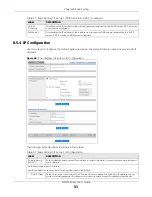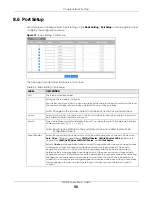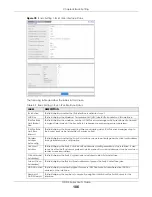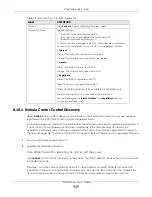
Chapter 8 Basic Setting
GS1915 Series User’s Guide
103
8.8 Interface Setup
An IPv6 address is configured on a per-interface basis. The interface can be a physical interface (for
example, an Ethernet port) or a virtual interface (for example, a VLAN). The Switch supports the VLAN
interface type for IPv6 at the time of writing.
Use this screen to set IPv6 interfaces on which you can configure an IPv6 address to access and
manage the Switch.
Click
Basic Setting
>
Interface Setup
in the navigation panel to display the configuration screen.
Power-Up
Set how the Switch provides power to a connected PD at power-up.
802.3af
– the Switch follows the IEEE 802.3af Power over Ethernet standard to supply power to the
connected PDs during power-up.
Legacy
– the Switch can provide power to the connected PDs that require high inrush currents at
power-up. Inrush current is the maximum, instantaneous input current drawn by the PD when first
turned on.
Pre-802.3at
– the Switch initially offers power on the port according to the IEEE 802.3af standard,
and then switches to support the IEEE 802.3at standard within 75 milliseconds after a PD is
connected to the port. Select this option if the Switch is performing 2-event Layer-1 classification
(PoE+ hardware classification) or the connected PD is NOT performing Layer 2 power
classification using Link Layer Discovery Protocol (LLDP).
802.3at
– the Switch supports the IEEE 802.3at High Power over Ethernet standard and can supply
power of up to 30 W per Ethernet port. IEEE 802.3at is also known as PoE+ or PoE Plus. An IEEE
802.3at compatible device is referred to as Type 2. Power Class 4 (High Power) can only be used
by Type 2 devices. If the connected PD requires a Class 4 current when it is turned on, it will be
powered up in this mode.
Force-802.3at
– the Switch offers power of up to 30 W on the port without performing PoE
hardware classification. Select this option if the connected PD does not comply with any PoE
standard and requests power higher than a standard power limit.
Max Power
(mW)
Specify the maximum amount of power the PD could use from the Switch on this port.
LLDP Power Via
MDI
Select this to have the Switch negotiate PoE power with the PD connected to the port by
transmitting LLDP Power Via MDI TLV frames. This helps the Switch allocate less power to the PD on
this port. The connected PD must be able to request PoE power through LLDP.
The Power Via MDI TLV allows PoE devices to advertise and discover the MDI power support
capabilities of the sending port on the remote device.
• Port Class
• MDI Supported
• MDI Enabled
• Pair Controllable
• PSE Power Pairs
• Power Class
Apply
Click
Apply
to save your changes to the Switch’s run-time memory. The Switch loses these
changes if it is turned off or loses power, so use the
Save
link on the top navigation panel to save
your changes to the non-volatile memory when you are done configuring.
Cancel
Click
Cancel
to begin configuring this screen afresh.
Table 36 Basic Setting > PoE Setup > PoE Setup (continued)
LABEL
DESCRIPTION
















































